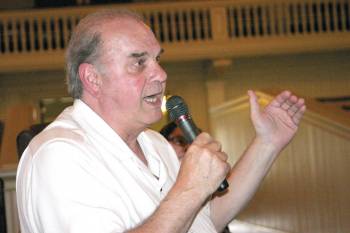
 |
|---|
| MAKING HIS POINT: Phil D’Ercole told DEM officials that conditions at Warwick Pond have deteriorated in the 10 years he’s lived on the pond. He blames Green Airport for the problem. |
At a workshop Wednesday night at City Council Chambers, Department of Environmental Management officials agreed they have not been on top of monitoring storm water runoff at Green Airport and that the current method for capturing deicing fluid sprayed on airplanes is inadequate.
“We rely on the Rhode Island Airport Corporation 100 percent,” Angelo Liberti, DEM chief of surface water protection, said in response to questions from Michelle Komar. Komar was one of a handful of residents to turn out for the session designed as a prelude to the May 14 hearing on RIAC’s Rhode Island Pollution Discharge Elimination System (RIPDES). The workshop was so poorly attended that, soon after starting, everyone gathered around the council conference table rather than take turns at a podium some distance away. Noticeably absent was representation from RIAC, which, under the terms of the permit, will build a $22 million collection and treatment system for propylene glycol sprayed on airplanes.
Pressed on why DEM would rely on RIAC to monitor the effectiveness of its collection systems, Liberti said, “We have a lot of other priorities. It is something we should commit to. It is a good point.”
So, will things improve?
“What they did before is not acceptable going forward,” Liberti said. “We believe it [the proposed system] will correct it.”
As outlined in schematics, gates would divert runoff from deicing areas at the terminal and the cargo area, which would then be pumped to holding tanks and a treatment facility on the east side of the airfield, not far from the maintenance garage. The system would be activated when it detects certain levels of glycol. After treatment, the water would be pumped into the city sewage system.
Presently, RIAC uses trucks to vacuum glycol from the tarmac. That system is estimated to capture about 40 percent of the chemical before it enters the storm water system, ending up in either Buckeye Brook or the brook’s watershed.
“What they’re doing now is not good. That’s why we wanted a new permit,” Liberti said.
But the fact that the new system is projected to capture only about 60 percent of the glycol prompted questions of whether that was sufficient.
DEM officials thought that was pretty good, as some of the glycol stays on the plane, some sticks to the asphalt and some is expected to fall outside of the collection area.
Eric Beck of the DEM Water Resources Division said that, after spraying, 77 percent of the glycol is available for collection. “They’re saying they’ll get 60 percent – I don’t know of a system that consistently collects more than that,” he said.
“They’re going beyond what the Environmental Protection Agency requires,” Liberti said of the airport plan. Further, he noted that the 60 percent figure is a projected average and, depending on conditions, the system could be collecting anywhere from 40 to 80 percent of the glycol.
Even at higher rates, any glycol ending up in Buckeye Brook or Warwick Pond is too much, said Phil D’Ercole. Since living on the pond for the past decade, D’Ercole said he is seeing fewer wild animals as well as deformities in some of the animals still living there. He said the pond water has lost its clarity and is murky and that, following winter storms, he has spotted a “bubbling skin” on the pond surface.
“We don’t want to see anything discharged into that water,” he said.
Beck said he didn’t think the airport is primarily responsible for the cloudy conditions of pond water. He attributed that to phosphorous from fertilizers, which stimulates the growth of algae that clouds the water.
“The airport is not a source of phosphorous. It doesn’t use much fertilizer,” he said.
Nonetheless, the conclusion of DEM testing is that the brook is “highly stressed throughout the watershed.”
Komar identified the former Truk-Away landfill, which RIAC bought, and the fact that the landfill was not properly capped, as a source of pollutants.
“Why isn’t the state being taken to task for Truk-Away?” she asked.
“That’s a good question,” Liberti answered.
The May 14 public hearing will be held at 6 p.m. in Room 300 of DEM offices at 235 Promenade St., Providence.